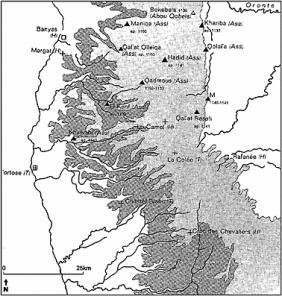Muslim Fortresses in the Levant: Between Crusaders and Mongols (60 page)
Read Muslim Fortresses in the Levant: Between Crusaders and Mongols Online
Authors: Kate Raphael
Tags: #Arts & Photography, #Architecture, #Buildings, #History, #Middle East, #Egypt, #Politics & Social Sciences, #Social Sciences, #Human Geography, #Building Types & Styles, #World, #Medieval, #Humanities

and this al-Qurayn … was among the fortresses that would harm Safad … and after the conquest of
al-Qurayn … was among the fortresses that would harm Safad … and after the conquest of al-Akrād and
al-Akrād and he [i.e. Baybars] saw that he cannot leave its conquest to his successor.
he [i.e. Baybars] saw that he cannot leave its conquest to his successor.
90
Large and forbidding fortresses fell within a few weeks. The lack of reinforcements was a fault the Franks could not overcome. Though the fortresses stored sufficient
quantities of water, arms and food, their fate was sealed if there was no military force available to threaten the besieging enemy camp. In addition to the decline in Frankish military abilities during the thirteenth century,
91
one must consider the remarkable efficiency displayed by the Mamluk siege armies. They used every known method in the art of siege warfare: tunnels were dug under towers and curtain walls, pots containing were thrown,
were thrown,
92
ladders and ropes were used to scale fortifications and every type of siege machine was employed.
93
In the early 1270s Baybars set out to eradicate the eleven fortresses in the Nasseriyya Mountains (
fortresses in the Nasseriyya Mountains (
Map 3.3
). The existence of an extreme Muslim sect whose loyalty to the Mamluks was rather doubtful was hardly conducive to the establishment of the Mamluk regime in Syria. In the spring of 1270 Masyāf was conquered and a Mamluk garrison established. In 1271–2 al-Khawābī, and
and

Map 3.3 fortresses in northwest Syria
fortresses in northwest Syria
were taken; the latter was given a Mamluk garrison to safeguard it. In 1273 Qadmūs and Manīqa surrendered to the sultan. Al-Qadmūs, Manīqa, , Masyāf and al-Kahf were probably returned to the
, Masyāf and al-Kahf were probably returned to the s by 1326. Ibn
s by 1326. Ibn , who passed through the region in that year, reports that the fortresses mentioned above can be entered only by members of the
, who passed through the region in that year, reports that the fortresses mentioned above can be entered only by members of the sect.
sect.
94 (d. 749/1349) mentions al-Kahf, al-Qadmūs, al-Khawābī,
(d. 749/1349) mentions al-Kahf, al-Qadmūs, al-Khawābī, and Masyāf as stops along the
and Masyāf as stops along the
barīd
route.
95
Thus they must have been integrated in the Mamluk array of fortifications. The conquest of the strongholds illustrates the use of fortresses to strengthen Mamluk rule and subdue hostile populations.
strongholds illustrates the use of fortresses to strengthen Mamluk rule and subdue hostile populations.